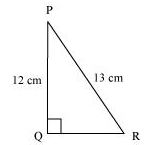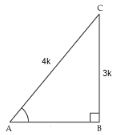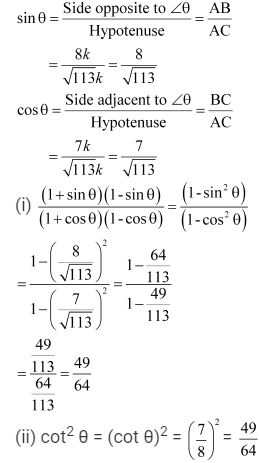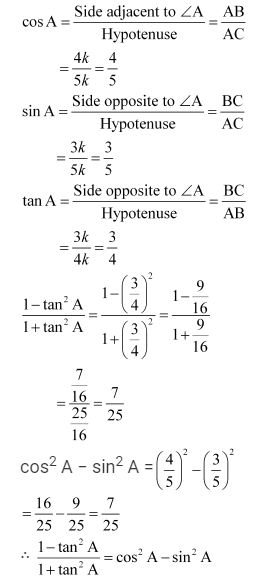NCERT Solution: Introduction to Trigonometry
In Δ ABC,∠B = 90º
By Applying Pythagoras theorem , we get
AC2 = AB2 + BC2 = (24)2 + 72 = (576+49) cm2 = 625 cm2
⇒ AC = 25
(i) sin A = BC/AC = 7/25
cos A = AB/AC = 24/25
(ii) sin C = AB/AC = 24/25
cos C = BC/AC = 7/25

By Applying Pythagoras theorem in ΔPQR , we get
PR2 = PQ2 + QR2 = (13)2 = (12)2 + QR2 = 169 = 144 + QR2
⇒ QR2 = 25 ⇒ QR = 5 cm
Now,
tan P = QR/PQ = 5/12
cot R = QR/PQ = 5/12
A/q
tan P – cot R = 5/12 - 5/12 = 0
Let ΔABC be a right-angled triangle, right-angled at B.
We know that sin A = BC/AC = 3/4
Let BC be 3k and AC will be 4k where k is a positive real number.

By Pythagoras theorem we get,
AC2 = AB2 + BC2
(4k)2 = AB2 + (3k)2
16k2 - 9k2 = AB2
AB2 = 7k2
AB = √7 k
cos A = AB/AC = √7 k/4k = √7/4
tan A = BC/AB = 3k/√7 k = 3/√7
Let ΔABC be a right-angled triangle, right-angled at B.
We know that cot A = AB/BC = 8/15 (Given)
Let AB be 8k and BC will be 15k where k is a positive real number.
By Pythagoras theorem we get,
AC2 = AB2 + BC2
AC2 = (8k)2 + (15k)2
AC2 = 64k2 + 225k2
AC2 = 289k2
AC = 17 k
sin A = BC/AC = 15k/17k = 15/17
sec A = AC/AB = 17k/8 k = 17/8
Let ΔABC be a right-angled triangle, right-angled at B.
We know that sec θ = OP/OM = 13/12 (Given)
Let OP be 13k and OM will be 12k where k is a positive real number.
By Pythagoras theorem we get,
OP2 = OM2 + MP2
(13k)2 = (12k)2 + MP2
169k2 - 144k2 = MP2
MP2 = 25k2
MP = 5
Now,
sin θ = MP/OP = 5k/13k = 5/13
cos θ = OM/OP = 12k/13k = 12/13
tan θ = MP/OM = 5k/12k = 5/12
cot θ = OM/MP = 12k/5k = 12/5
cosec θ = OP/MP = 13k/5k = 13/5
Let ΔABC in which CD ⊥ AB.
A/q,
cos A = cos B
⇒ AD/AC = BD/BC
⇒ AD/BD = AC/BC
Let AD/BD = AC/BC = k
⇒ AD = kBD .... (i)
⇒ AC = kBC .... (ii)
By applying Pythagoras theorem in ΔCAD and ΔCBD we get,
CD2 = AC2 - AD2 …. (iii)
and also CD2 = BC2 - BD2 …. (iv)
From equations (iii) and (iv) we get,
AC2 - AD2 = BC2 - BD2
⇒ (kBC)2 - (k BD)2 = BC2 - BD2
⇒ k2 (BC2 - BD2) = BC2 - BD2
⇒ k2 = 1
⇒ k = 1
Putting this value in equation (ii), we obtain
AC = BC
⇒ ∠A = ∠B (Angles opposite to equal sides of a triangle are equal-isosceles triangle)
Let ΔABC in which ∠B = 90º and ∠C = θ
cot θ = BC/AB = 7/8
Let BC = 7k and AB = 8k, where k is a positive real number.
By Pythagoras theorem in ΔABC we get.
AC2 = AB2 + BC2
AC2 = (8k)2 + (7k)2
AC2 = 64k2 + 49k2
AC2 = 113k2
AC = √113 k

Let ΔABC in which ∠B = 90º,
cot A = AB/BC = 4/3
Let AB = 4k and BC = 3k, where k is a positive real number.
By Pythagoras theorem in ΔABC we get.
AC2 = AB2 + BC2
AC2 = (4k)2 + (3k)2
AC2 = 16k2 + 9k2
AC2 = 25k2
AC = 5k
tan A = BC/AB = 3/4
sin A = BC/AC = 3/5
cos A = AB/AC = 4/5
